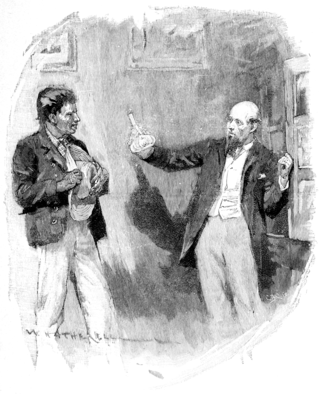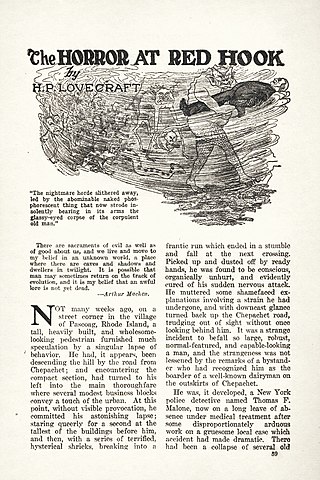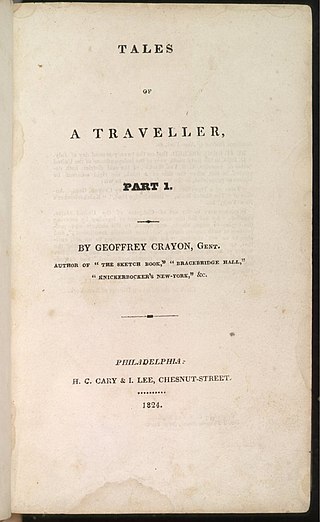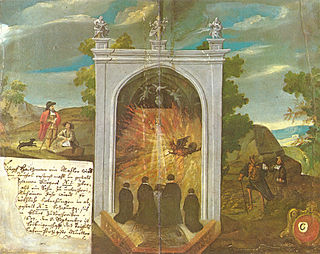American folklore encompasses the folklore that has evolved in the present-day United States mostly since the European colonization of the Americas. It also contains folklore that dates back to the Pre-Columbian era.

Faust is the protagonist of a classic German legend based on the historical Johann Georg Faust.

"The Legend of Sleepy Hollow" is an 1820 short story by American author Washington Irving, contained in his collection of 34 essays and short stories titled The Sketch Book of Geoffrey Crayon, Gent. Irving wrote the story while living in Birmingham, England.
"The Devil and Daniel Webster" (1936) is a short story by American writer Stephen Vincent Benét. He tells of a New Hampshire farmer who sells his soul to the devil and is later defended by a fictionalized Daniel Webster, a noted 19th-century American statesman, lawyer and orator. The narrative references real events in the lives of Webster and his family.

Treasure is a concentration of wealth — often originating from ancient history — that is considered lost and/or forgotten until rediscovered. Some jurisdictions legally define what constitutes treasure, such as in the British Treasure Act 1996.

"Rip Van Winkle" is a short story by the American author Washington Irving, first published in 1819. It follows a Dutch-American villager in colonial America named Rip Van Winkle who meets mysterious Dutchmen, imbibes their strong liquor and falls deeply asleep in the Catskill Mountains. He awakes 20 years later to a very changed world, having missed the American Revolution.

Buried treasure is a literary trope commonly associated with depictions of pirates, alongside Vikings, criminals, and Old West outlaws. According to popular conception, these people often buried their stolen fortunes in remote places, intending to return to them later.
Old Scratch or Mr. Scratch is a nickname or pseudonym for the Devil. The name likely comes from Middle English scrat, the name of a demon or goblin, derived from Old Norse skratte.

"The Bottle Imp" is an 1891 short story by the Scottish author Robert Louis Stevenson usually found in the short story collection Island Nights' Entertainments. It was first published in the New York Herald and Black and White magazine. In it, the protagonist buys a bottle with an imp inside that grants wishes. However, the bottle is cursed; if the holder dies bearing it, his or her soul is forfeit to hell.

"Bearskin" is a fairy tale collected by the Brothers Grimm. A variant from Sicily, "Don Giovanni de la Fortuna", was collected by Laura Gonzenbach in Sicilianische Märchen and included by Andrew Lang in The Pink Fairy Book. Italo Calvino included another Italian version, "The Devil's Breeches" from Bologna, in his Italian Folktales.

"The Horror at Red Hook" is a short story by American writer H. P. Lovecraft, written on August 1–2, 1925. "Red Hook" is a transitional tale, situated between the author's earlier work and the later Cthulhu Mythos. Although the story depicts a sinister cult, this cult offers a conventionally occult devil-worshipping threat, rather than the cosmic threat depicted in his later work. Living in poverty in the slum of Red Hook at the time of writing, Lovecraft was at this time urgently attempting to widen his markets in the pulp magazines. By having an unusually proactive Irish New York police detective as his protagonist, he hoped for a swift sale to a detective pulp, which would have opened up a new market other than his usual Weird Tales magazine. He did not get such a sale, and had to fall back on Weird Tales. "Red Hook" was thus first published in the January 1927 issue of Weird Tales.
The New Jersey Pine Barrens has been the site of many legends, tales and mythical creatures, many of which have been documented by Weird NJ in its magazines and books.

The Devil and Daniel Webster is a 1941 American supernatural film based on the 1938 play adaptation of Stephen Vincent Benét's 1936 short story "The Devil and Daniel Webster". The play by Benét was in turn based on the libretto created by Benét for an opera adaptation of his short story with composer Douglas Moore, a project he began writing in 1937. Benét and Dan Totheroh adapted the play into the film's screenplay.

Tales of a Traveller, by Geoffrey Crayon, Gent. (1824) is a two-volume collection of essays and short stories composed by Washington Irving while he was living in Europe, primarily in Germany and Paris. The collection was published under Irving's pseudonym, Geoffrey Crayon, Gent.
"Daniel and the Devil" is an 1888 short story by the American journalist and poet Eugene Field. Similar in subject matter and setting to other American "pact with the Devil" or Faust stories, such as "Young Goodman Brown" by Nathaniel Hawthorne and Washington Irving's "The Devil and Tom Walker," Field's story varies significantly in allowing the Faust character (Daniel) to escape from the bargain.

The idea of making a deal with the devil has appeared many times in works of popular culture. These pacts with the Devil can be found in many genres, including: books, music, comics, theater, movies, TV shows and games. When it comes to making a contract with the Devil, they all share the same prevailing desire, a mortal wants some worldly good for their own selfish gain, but in exchange, they must give up their soul for eternity.

The Headless Horseman is an archetype of mythical figure that has appeared in folklore around Europe since the Middle Ages. The figures are traditionally depicted as riders upon horseback who are missing their heads. These myths have since inspired a number of stories and characters in popular culture, including The Legend of Sleepy Hollow.
"Kidd the Pirate" is a short story by the American author Washington Irving, based on legends of Captain William Kidd. The story was published in Tales of a Traveller, an 1824 collection of Irving's writings, where it immediately precedes that work's most famous story "The Devil and Tom Walker", which also involves Kidd's treasure.

Heart of Stone is a fairy tale written by Wilhelm Hauff. It was published in 1827 in a collection of fairy tales that take place within the narrative of The Spessart Inn. It was adapted into film, including Heart of Stone (1924) and Heart of Stone (1950).
The Devil and Daniel Webster is a folk opera in one act by American composer Douglas Moore. The opera's English-language libretto was written by Stephen Vincent Benét who also penned the 1936 short story of the same name upon which the work is based.














